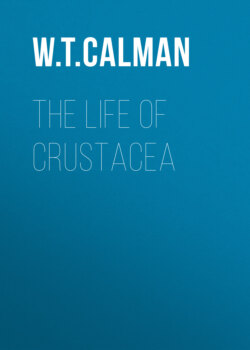Читать книгу The Life of Crustacea - W. T. Calman - Страница 10
На сайте Литреса книга снята с продажи.
CHAPTER III THE CLASSIFICATION OF CRUSTACEA
ОглавлениеTable of Contents
Table of Classification of Crustacea
| Class CRUSTACEA. | |||||
| Subclass | Branchiopoda | - | { | Order | Anostraca. |
| { | " | Notostraca. | |||
| { | " | Conchostraca. | |||
| { | " | Cladocera. | |||
| " | Ostracoda | - | { | " | Myodocopa. |
| { | " | Podocopa. | |||
| " | Copepoda | - | { | " | Eucopepoda. |
| { | " | Branchiura. | |||
| " | Cirripedia | - | { | " | Thoracica. |
| { | " | Rhizocephala. | |||
| " | Malacostraca. | ||||
| Series | LEPTOSTRACA | - | " | Nebaliacea. | |
| " | EUMALACOSTRACA. | ||||
| Division | Syncarida | - | " | Anaspidacea. | |
| " | Peracarida | - | { | " | Mysidacea. |
| { | " | Cumacea. | |||
| { | " | Tanaidacea. | |||
| { | " | Isopoda. | |||
| { | " | Amphipoda. | |||
| " | Eucarida | - | { | " | Euphausiacea. |
| { | " | Decapoda. | |||
| " | Hoplocarida | - | { | " | Stomatopoda. |
Fig. 10—The "Fairy Shrimp" (Chirocephalus diaphanus), Male. × 2. (After Baird.)
View larger image
Occasionally there may be found in rain-water puddles and the like, in the South of England, a beautiful, transparent, shrimp-like animal, an inch or more in length, to which the name of "Fairy Shrimp" has been given (Fig. 10). It is known in technical zoology as Chirocephalus diaphanus, and is a representative of the subclass Branchiopoda. The members of this group are distinguished from other Crustacea by their flattened, leaf-like feet, each of which is divided into a number of lobes, and has a gill plate on the outer side. In Chirocephalus there is no carapace, and the head is followed by eleven distinct body segments, each bearing a pair of leaf-like, or rather fin-like, feet. The hinder part of the body has no appendages, and ends in a forked tail. In the female a large pouch hangs from the under-side of the body, just behind the limb-bearing part, and is often found filled with eggs. In the male, a pair of remarkable-looking appendages, each shaped somewhat like a hand with webbed fingers, hang in front of the head. These are connected with the antennæ, and are known as the "claspers," from their function in seizing and holding the female. The eyes are set on movable stalks. Those Branchiopoda which, like Chirocephalus, have no carapace, form the order Anostraca.
